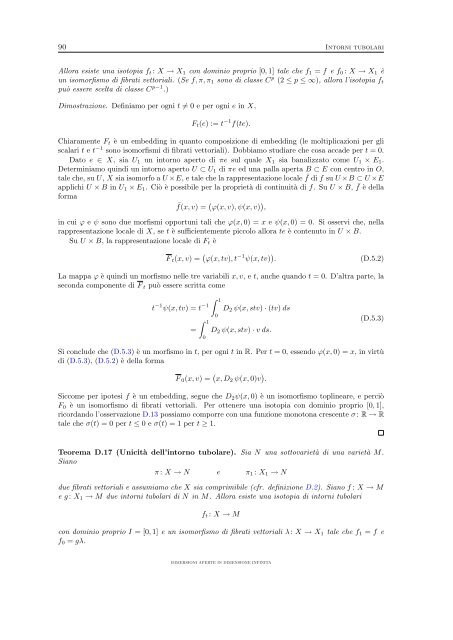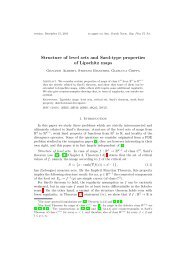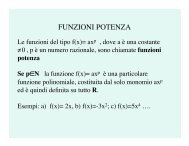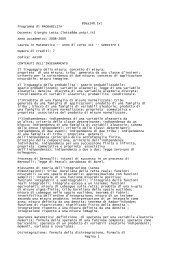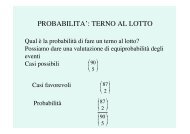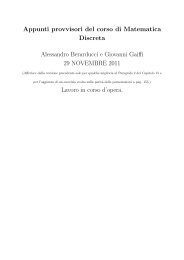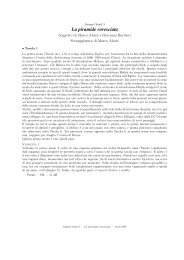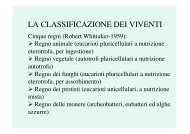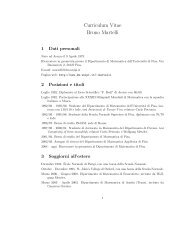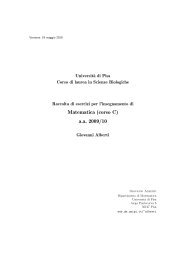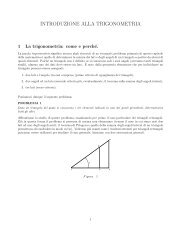Immersioni aperte in dimensione infinita - Dipartimento di Matematica
Immersioni aperte in dimensione infinita - Dipartimento di Matematica
Immersioni aperte in dimensione infinita - Dipartimento di Matematica
You also want an ePaper? Increase the reach of your titles
YUMPU automatically turns print PDFs into web optimized ePapers that Google loves.
90 Intorni tubolari<br />
Allora esiste una isotopia ft : X → X1 con dom<strong>in</strong>io proprio [0, 1] tale che f1 = f e f0 : X → X1 è<br />
un isomorfismo <strong>di</strong> fibrati vettoriali. (Se f, π, π1 sono <strong>di</strong> classe C p (2 ≤ p ≤ ∞), allora l’isotopia ft<br />
può essere scelta <strong>di</strong> classe C p−1 .)<br />
Dimostrazione. Def<strong>in</strong>iamo per ogni t = 0 e per ogni e <strong>in</strong> X,<br />
Ft(e) := t −1 f(te).<br />
Chiaramente Ft è un embedd<strong>in</strong>g <strong>in</strong> quanto composizione <strong>di</strong> embedd<strong>in</strong>g (le moltiplicazioni per gli<br />
scalari t e t −1 sono isomorfismi <strong>di</strong> fibrati vettoriali). Dobbiamo stu<strong>di</strong>are che cosa accade per t = 0.<br />
Dato e ∈ X, sia U1 un <strong>in</strong>torno aperto <strong>di</strong> πe sul quale X1 sia banalizzato come U1 × E1.<br />
Determ<strong>in</strong>iamo qu<strong>in</strong><strong>di</strong> un <strong>in</strong>torno aperto U ⊂ U1 <strong>di</strong> πe ed una palla aperta B ⊂ E con centro <strong>in</strong> O,<br />
tale che, su U, X sia isomorfo a U ×E, e tale che la rappresentazione locale ¯ f <strong>di</strong> f su U ×B ⊂ U ×E<br />
applichi U × B <strong>in</strong> U1 × E1. Ciò è possibile per la proprietà <strong>di</strong> cont<strong>in</strong>uità <strong>di</strong> f. Su U × B, ¯ f è della<br />
forma<br />
¯f(x, v) = ϕ(x, v), ψ(x, v) ,<br />
<strong>in</strong> cui ϕ e ψ sono due morfismi opportuni tali che ϕ(x, 0) = x e ψ(x, 0) = 0. Si osservi che, nella<br />
rappresentazione locale <strong>di</strong> X, se t è sufficientemente piccolo allora te è contenuto <strong>in</strong> U × B.<br />
Su U × B, la rappresentazione locale <strong>di</strong> Ft è<br />
F t(x, v) = ϕ(x, tv), t −1 ψ(x, tv) . (D.5.2)<br />
La mappa ϕ è qu<strong>in</strong><strong>di</strong> un morfismo nelle tre variabili x, v, e t, anche quando t = 0. D’altra parte, la<br />
seconda componente <strong>di</strong> F t può essere scritta come<br />
t −1 ψ(x, tv) = t −1<br />
1<br />
=<br />
1<br />
0<br />
0<br />
D2 ψ(x, stv) · (tv) ds<br />
D2 ψ(x, stv) · v ds.<br />
(D.5.3)<br />
Si conclude che (D.5.3) è un morfismo <strong>in</strong> t, per ogni t <strong>in</strong> R. Per t = 0, essendo ϕ(x, 0) = x, <strong>in</strong> virtù<br />
<strong>di</strong> (D.5.3), (D.5.2) è della forma<br />
F 0(x, v) = x, D2 ψ(x, 0)v .<br />
Siccome per ipotesi f è un embedd<strong>in</strong>g, segue che D2ψ(x, 0) è un isomorfismo topl<strong>in</strong>eare, e perciò<br />
F0 è un isomorfismo <strong>di</strong> fibrati vettoriali. Per ottenere una isotopia con dom<strong>in</strong>io proprio [0, 1],<br />
ricordando l’osservazione D.13 possiamo comporre con una funzione monotona crescente σ : R → R<br />
tale che σ(t) = 0 per t ≤ 0 e σ(t) = 1 per t ≥ 1.<br />
Teorema D.17 (Unicità dell’<strong>in</strong>torno tubolare). Sia N una sottovarietà <strong>di</strong> una varietà M.<br />
Siano<br />
π : X → N e π1 : X1 → N<br />
due fibrati vettoriali e assumiamo che X sia comprimibile (cfr. def<strong>in</strong>izione D.2). Siano f : X → M<br />
e g : X1 → M due <strong>in</strong>torni tubolari <strong>di</strong> N <strong>in</strong> M. Allora esiste una isotopia <strong>di</strong> <strong>in</strong>torni tubolari<br />
ft : X → M<br />
con dom<strong>in</strong>io proprio I = [0, 1] e un isomorfismo <strong>di</strong> fibrati vettoriali λ: X → X1 tale che f1 = f e<br />
f0 = gλ.<br />
IMMERSIONI APERTE IN DIMENSIONE INFINITA


